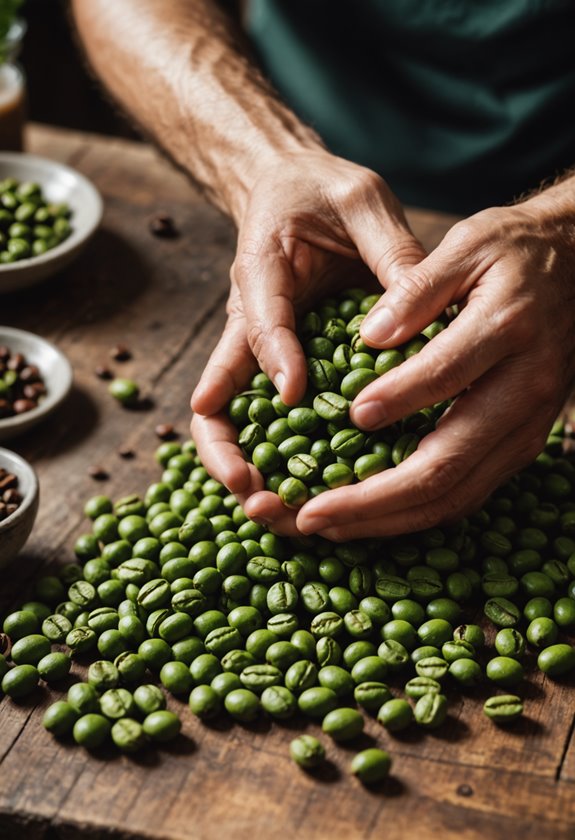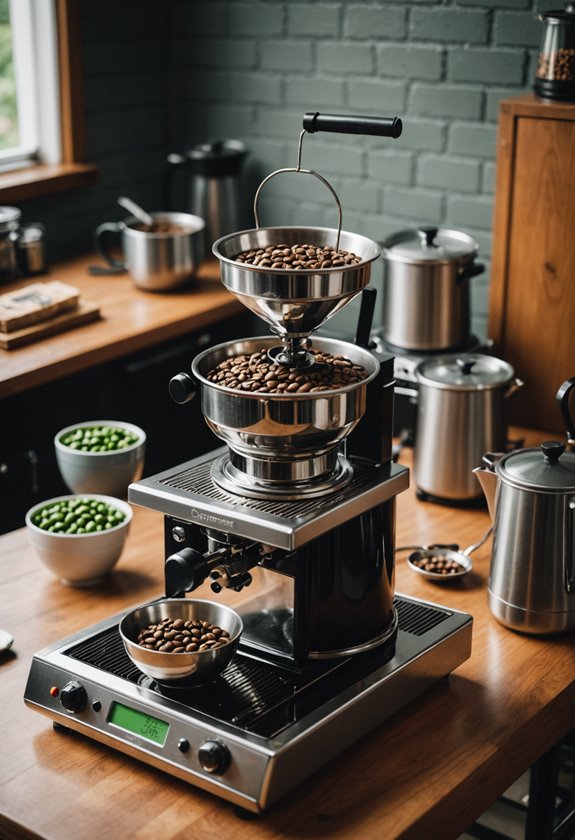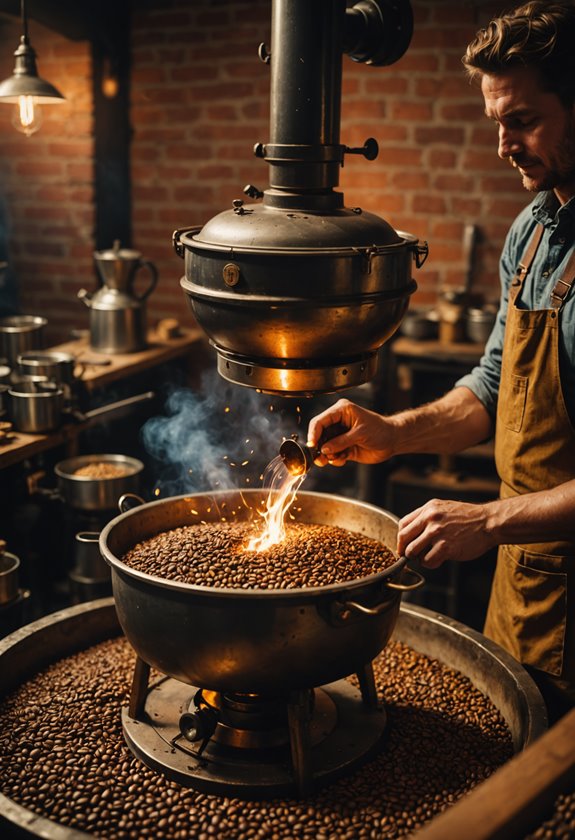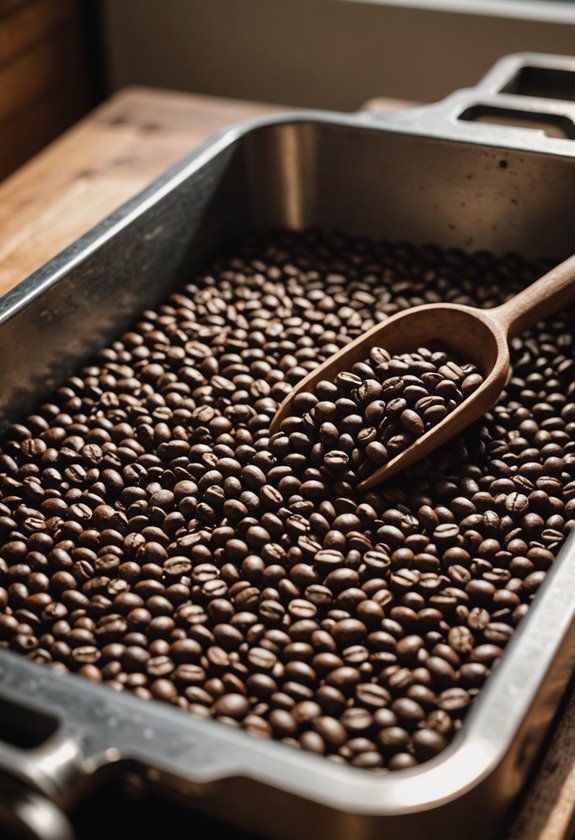How Do You Roast Green Coffee Beans
To roast green coffee beans, start by selecting beans with your preferred profile—Arabica for smoothness or Robusta for strength. Let's investigate the tools you'll need: a roasting machine, or simply a pan, thermometer, and stirring utensil for stovetop roasting. Begin by preheating to about 375°F, spreading beans in a single layer. Stir consistently to guarantee even roasting. Keep an eye on color changes; from green to yellow to brown. Listen for the first crack, indicating a light roast. Once you've achieved your desired roast level, cool the beans swiftly. Store them in airtight containers, and for more flavorful details, there's more to discover.
Summary of Key Findings
- Select quality green beans based on origin, variety, and desired flavor profile for optimal roasting results.
- Choose a roasting method: stovetop, oven, or air popper, each offering unique control and flavor.
- Monitor the roast by observing bean color changes and using a thermometer for precise temperature control.
- Cool roasted beans rapidly using a colander or baking sheet to stop the roasting process.
- Store cooled beans in airtight containers in a cool, dark place to maintain freshness.
Selecting the Right Beans

Choosing the right green coffee beans is crucial if you want to achieve the perfect roast. Let's investigate how to select beans that will make your roasting experience successful.
Origin Matters
Begin by considering the bean's origin. Coffee-growing regions, like Ethiopia, Brazil, or Colombia, each offer unique flavor profiles.
Ethiopian beans might've floral and fruity notes, while Brazilian ones can be nutty and chocolatey. Knowing where your beans come from helps you predict the flavors you'll develop.
Bean Variety
Next, focus on the bean variety. Arabica and Robusta are the two main types.
Arabica beans are known for their smooth taste and aromatic complexity, whereas Robusta beans are more bitter and contain more caffeine. Think about what flavor you're aiming for.
Processing Method
Pay attention to the processing method too. Beans can be washed, natural, or honey processed.
Washed beans have a cleaner taste, while natural ones offer fruitier notes. Honey processed beans give a balance of both.
Quality Indicators
Finally, look for quality indicators like bean size and uniformity.
Consistent size guarantees even roasting. Avoid beans with defects or visible damage, as they can negatively affect taste. When selecting green coffee beans, understanding medium roast characteristics can help you choose the best beans for your roasting needs, which can be found on our website that sells products related to coffee beans medium roast.
Understanding Roast Levels
Roasting converts green coffee beans into the aromatic, flavorful coffee we love, and understanding roast levels is key to achieving your desired taste.
Let's examine the different stages of roasting, which range from light to dark, each offering unique flavors and characteristics.
Light Roasts
Light roasts are for those who prefer a mild cup with bright acidity.
These beans are roasted until the first crack, which occurs when the beans expand and make a popping sound.
You'll notice flavors like floral, fruity, and sometimes herbal notes because the bean's original characteristics remain intact.
Medium Roasts
If you enjoy a balanced flavor profile, medium roasts are your best choice.
They go a bit beyond the first crack but stop before the second.
These beans have a richer, more developed flavor, often with notes of caramel and chocolate, while still retaining some of the bean's original essence.
Dark Roasts
Dark roasts produce a bold, intense flavor with less acidity.
These beans continue to roast past the second crack, leading to an oily surface.
The roasting process dominates the bean's natural flavors, resulting in smoky, bittersweet notes.
This roast level is perfect if you prefer strong, vigorous flavors.
Choosing the right Burr Grinder can also enhance the overall coffee experience by providing freshly ground coffee with rich, aromatic flavors.
Tools and Equipment

Let's examine the essential tools you'll need to start roasting your own green coffee beans at home.
Choosing quality equipment is vital, so you'll want to take into account options like a home coffee roaster or a simple popcorn maker, each offering unique benefits.
Don't forget that regular maintenance and care, such as cleaning and checking for wear, will guarantee your equipment lasts longer and performs at its best.
When selecting a grinder for your green coffee beans, consider a model with stainless steel blades for durability and easy cleaning to ensure optimal flavor and longevity.
Essential Roasting Tools
To initiate your coffee roasting adventure, you'll need a few essential tools to guarantee success. First, understand that your setup doesn't have to be overly complex, but specific tools will make the process much more manageable. Let's investigate what you'll need to get started.
Basic Roasting Tools
- Roasting Machine or Pan: Choose between an electric roaster or a simple stovetop pan. Electric roasters offer consistent results, while pans provide hands-on control.
- Cooling Tray: Vital for halting the roasting process. A simple metal tray works, but dedicated cooling trays enhance airflow.
- Thermometer: This tool guarantees precise temperature control. Roasting temperatures can impact flavor, so accuracy is key.
- Timer: Timing is essential. A timer helps track roast stages, ensuring beans hit the right profile.
- Wooden Spoon or Spatula: Stirring beans evenly during roasting prevents scorching and promotes uniformity.
Here's a quick summary:
| Tool | Purpose |
|---|---|
| Roasting Machine | Consistent roasting |
| Cooling Tray | Stops roasting quickly |
| Thermometer | Monitors temperature accurately |
| Timer | Tracks roasting duration |
| Wooden Spoon | Guarantees even roasting |
With these tools, you'll be well-equipped to begin your coffee roasting expedition and achieve flavorful results.
Choosing Quality Equipment
Having gathered your basic roasting tools, it's important to focus on selecting quality equipment to secure the best results. Quality equipment guarantees consistency, efficiency, and flavor retention during the roasting process.
Let's investigate some key items you should take into account to enhance your coffee roasting expedition.
First, investing in a reliable coffee roaster is vital. It should offer precise temperature control and consistent heat distribution. Look for a durable model that matches your roasting scale and preferences.
Additionally, a quality thermometer is necessary for monitoring bean temperature and assuring even roasting. You'll also want a sturdy cooling tray to quickly cool the beans, preventing over-roasting and preserving flavor.
Here's a helpful list of essential equipment to take into account:
- Coffee Roaster: Choose one that suits your needs and offers reliable temperature control.
- Thermometer: Accurate readings help maintain consistency during roasting.
- Cooling Tray: Aids in quickly cooling your beans to lock in flavor.
- Grinder: Opt for one that provides consistent grind size for maximum extraction.
- Storage Containers: Airtight containers keep roasted beans fresh for longer periods.
Maintenance and Care
Regular maintenance and care of your coffee roasting equipment are essential for ensuring longevity and ideal performance.
Let's investigate how you can keep your tools in top shape.
Cleaning the Roaster
After each roasting session, remove any chaff, the thin outer layer of the coffee bean, from the roaster.
Chaff can block airflow, affecting roast quality. Use a vacuum cleaner or canned air for hard-to-reach areas.
Clean the roasting chamber with a damp cloth, but avoid harsh chemicals that might damage the surface.
Inspecting Parts
Regularly inspect the ventilation system, looking for blockages or damage.
Check the heating element for any wear and tear, ensuring it operates efficiently.
If you notice any inconsistencies, don't hesitate to replace parts to avoid compromising your roast.
Calibration
Over time, sensors and controls can drift, affecting the roast profile.
Calibrate your equipment periodically to maintain temperature accuracy.
Follow the manufacturer's instructions for calibration, which often involve adjusting settings until they align with standard measurements.
Storing Equipment
Store your roaster in a dry, cool place, away from direct sunlight.
Cover it with a cloth or plastic to protect it from dust.
Proper storage prevents rust and other environmental damage, keeping your equipment ready for the next roast.
Preparing Your Workspace
Before you start roasting green coffee beans, it's crucial to prepare your workspace for a smooth and efficient process. A well-organized area guarantees you have everything you need at your fingertips, minimizing interruptions and maximizing your focus on the roast.
Let's examine how to set up your space effectively.
Begin by selecting a ventilation-friendly location. Roasting coffee beans produces smoke and aromas, so you'll want a place with good airflow, like a kitchen with an exhaust fan or an outdoor area.
Next, gather your tools—these might include a roasting machine, a heatproof container for cooling, and a protective surface to prevent damage from heat. Organizing these items within reach will streamline your process.
Confirm your workspace is clean and clutter-free. This helps avoid accidents and guarantees you can focus on the task at hand.
Also, have a fire extinguisher nearby as a safety precaution, just in case.
Consider the following checklist to prepare your workspace:
- Adequate ventilation
- Necessary tools in place
- Clean and organized surface
- Heatproof container ready
- Fire extinguisher within reach
To achieve the perfect roast, it's essential to consider the type of coffee creamer you will use, such as Folgers Coffee, which can enhance the flavor of your roasted beans.
Roasting Methods Explained

When it comes to roasting green coffee beans, understanding the different methods is key to finding the one that suits your style and preferences.
Let's investigate three popular methods: stovetop, oven, and air popper.
Stovetop Roasting
This traditional method requires just a pan and a heat source.
You'll need to constantly stir the beans to guarantee even roasting, making it a hands-on approach.
This method gives you great control over the process, but you'll need to be attentive to avoid uneven roasting or burning.
Oven Roasting
If you prefer a more passive approach, oven roasting is an option.
Spread your beans in a single layer on a baking sheet and place them in a preheated oven.
It takes longer than stovetop roasting, and you might need to mix the beans occasionally for uniformity.
Expect some smoke, so good ventilation is a must.
Air Popper Roasting
Using a hot air popcorn popper can be an efficient method.
It works like a mini fluid bed roaster, circulating hot air to roast the beans evenly.
This method is quick and requires minimal effort, but not all poppers are suitable, so check for compatibility.
When choosing a coffee grinder for roasting green coffee beans, consider a grinder with burr grinder mechanism for consistent grind quality, which is essential for even extraction and flavor.
Monitoring the Roast
Let's investigate how monitoring the roast involves observing color changes and controlling temperature to achieve the perfect coffee flavor.
As the beans progress from green to yellow, then to brown, you'll notice distinct phases that require precise temperature adjustments.
Roast Color Changes
As you begin to roast your green coffee beans, understanding the changes in color will guide you through the process. Watching the beans change from green to yellow and then brown is key.
You'll notice the color changes in stages that indicate the roast level and flavor development. As the beans heat up, they lose moisture, and their natural sugars caramelize, altering the color and flavor profile.
Let's examine the stages of roast color changes:
- Green to Yellow: Initially, the beans start green and then turn yellow as they dry out.
- Yellow to Light Brown: As roasting continues, the beans achieve a light brown hue, signifying the onset of caramelization.
- Light Brown to Medium Brown: The beans darken further, and you might begin to perceive a nutty aroma.
- Medium Brown to Dark Brown: At this stage, the beans are nearing a classic roast level, and the surface oils become more prominent.
- Dark Brown to Very Dark: The beans reach their darkest, potentially leading to a smoky flavor if not carefully monitored.
Monitoring these color changes helps you achieve the desired roast profile, balancing both flavor and aroma to suit your taste preferences.
Temperature Control Techniques
Maintaining precise temperature control is crucial for a successful coffee roast, and a few techniques can help you monitor it effectively. Let's investigate how you can keep tabs on the roasting temperature. First, invest in a quality thermometer that can withstand high temperatures, as it will be your best friend during the roast. You'll need to keep a close eye on the temperature changes to guarantee the beans develop the desired flavor profile.
Monitoring Tools
Here's a simple table to illustrate some tools and techniques for monitoring temperature:
| Tool/Technique | Description | Importance |
|---|---|---|
| Thermometer | Measures roast temperature | Essential for accuracy |
| Roaster's Temperature Dial | Adjusts heat levels | Controls roast progression |
| Temperature Logger | Records temperature over time | Tracks roast consistency |
| Visual Inspection | Observes color and texture changes | Complements temperature data |
| Smell Assessment | Identifies aroma changes during roasting | Indicates roast stages |
When using these tools, make certain to take regular readings and adjust the heat as needed to maintain a steady progression. Temperature control requires attention to detail, so stay focused to achieve that perfect roast. Remember, each type of bean might require different settings, so experimentation is key.
Cooling and Storing Beans

Once your green coffee beans are perfectly roasted, it's crucial to cool them rapidly to halt the roasting process. This guarantees that they don't overcook, preserving the flavor and aroma you've worked hard to achieve.
Use a colander or a baking sheet; spread the beans in a thin layer, allowing air to circulate around them. You can also use a fan to speed up the cooling process. Remember, the quicker you cool them, the better the results.
After cooling, storing your beans correctly is essential for maintaining their freshness and quality. Let's examine some tips for effective storage:
- Use airtight containers: This prevents exposure to air, which can make your beans go stale faster.
- Store in a cool, dark place: Light and heat can degrade the beans over time.
- Avoid the fridge: The cold temperature can cause condensation, which isn't good for the beans.
- Label your containers: Include the roast date to keep track of freshness.
- Don't grind until needed: Whole beans stay fresher longer than ground coffee.
Tasting Your Coffee
Tasting your coffee is an art that combines sensory evaluation with personal preference. When you roast coffee, you reveal flavors and aromas unique to each bean. Begin by examining the brew's appearance, taking note of its color and clarity. Next, inhale deeply and identify the scent: is it nutty, floral, or perhaps fruity? Let the aroma guide your first sip. As the liquid meets your palate, focus on three key elements: acidity, body, and flavor. Acidity refers to the tang or brightness, while body describes the thickness or weight. Flavor encompasses the range of tastes—chocolatey, citrusy, or even spicy.
Let's investigate these elements further:
| Element | Description | Example Flavors |
|---|---|---|
| Acidity | Brightness or tanginess | Citrus, Berry |
| Body | Thickness or weight | Creamy, Light |
| Flavor | Range of taste profiles | Chocolate, Floral |
Frequently Asked Questions
What Is the Ideal Humidity Level for Storing Green Coffee Beans?
You should store green coffee beans at around 60% relative humidity. This level prevents mold growth while maintaining quality. Keep them in a cool, dark place, and use airtight containers to avoid moisture fluctuations.
How Does Altitude Affect the Roasting Process of Coffee Beans?
Altitude impacts coffee bean density and moisture content. You'll find high-altitude beans denser, requiring more heat and longer roasting times. Lower altitude beans need less heat. Adjust your roasting profile to achieve balanced flavors.
Can I Roast Decaffeinated Green Coffee Beans the Same Way?
Yes, you can roast decaffeinated green coffee beans the same way as regular beans. Just watch the temperature closely. Decaf beans roast faster and can burn easily, so adjust your timing to achieve the perfect roast.
What Are the Signs of Over-Roasting Green Coffee Beans?
You'll notice over-roasted green coffee beans by their dark color, burnt smell, and oily surface. The taste turns bitter and ashy, losing the desirable flavors. Keep a close eye to avoid this mistake.
Is It Possible to Roast Coffee Beans Using Solar Energy?
Yes, you can roast coffee beans using solar energy. You'll need a solar roaster, which uses mirrors to concentrate sunlight, generating enough heat. It's eco-friendly, but make certain consistent sunlight for even roasting. Give it a try!
Conclusion
Now that you've examined the ins and outs of roasting green coffee beans, you're ready to engage in the process yourself. Remember, selecting the right beans and understanding roast levels are essential. Use the right tools, prepare your workspace, and choose a roasting method that suits you. Monitor the roast closely, cool and store your beans properly, and finally, enjoy tasting your homemade coffee. With practice and patience, you'll become proficient in the art of coffee roasting.







